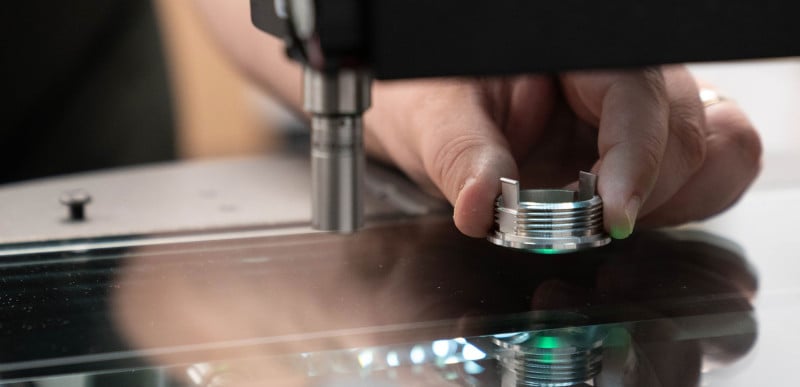
PTI Tech
Accelerating MIM Prototyping with Metal Binder Jetting
The Challenge
PTI Tech is a global contract manufacturer of precision injection-molded components specializing in engineered polymers and metal injection molding (MIM). In the latter process, powdered metal is mixed with a binder and then injected into a mold cavity under high pressure. “Green” parts must go through a debinding and sintering process, which yields high-quality, high-density metal parts.
PTI Tech specializes in producing complex, high-precision parts for mission-critical industries, including aerospace, defense, medical devices, and high-end industrial applications. PTI runs its customers’ part designs through a design for manufacturability (DFM) process to ensure that they can be cost-effectively produced using either plastic or metal injection molding.
A major elevator manufacturer was using button caps and button bodies made of stainless steel with a plastic over-molded assembly. Cleaning with strong disinfectants was causing the plastic threads to crack and deteriorate. The manufacturer had an urgent need to redesign the button body and cap as a more durable all-metal assembly using 316L Stainless Steel.
It needed to bring these parts to market quickly, so they could be retrofitted to existing elevators in the field. The button body design featured a pair of flexible retaining tabs that needed to be thin enough to be flexed by hand but retain their shape without cracking.
PTI Tech needed a manufacturing technology that could produce a series of production-representative parts that its client could use for testing and design validation. These parts needed to be similar in processing and physical characteristics to MIMproduced parts so PTI Tech could finalize their design before production tooling was built.
— Gaetano Mariella Chief Technology Officer“The shrinkage and final density that we achieve with binder-jetted parts are very similar to metal injection-molded parts."

The Solution
Metal binder jetting and metal injection molding have several similarities: They are both sintered metal powder processes that produce parts with similar mechanical properties, according to a report produced by PTI Tech. They also exhibit similar shrinkage behavior during sintering.
PTI Tech selected Markforged binder jetting to quickly produce a succession of elevator button assembly prototypes for the client to test. It produced parts that had a similar percentage of shrinkage during sintering, density, and surface finish to parts produced using metal injection molding, according to Neal Goldenberg, PTI Tech’s president. The part met the requirements emphasizing significant parity with the final MIM part. The flexible tabs and several thin-wall features met PTI’s requirements for durability, ensuring that they would not break off during in-field installations.
Without metal binder jetting, PTI Tech would have needed to build a series of pre-production molding tools to test a series of tab thicknesses and other part design variables. This would have taken up to 16 weeks, with a new tool needing to be fabricated for each iteration, Goldenberg emphasizes. With metal binder jetting, PTI Tech was able to conduct a thorough DFM process and still deliver several rounds of 275-300 pre-production parts to the client for testing – without any tooling – in only four weeks.
The customer’s engineering team was able to perform functional and destructive testing. They were also able to analyze the prototype parts’ structural performance and make tweaks to their aesthetics and dimensions, without investing in fixed tooling. Once the design was finalized, the customer was able to order the MIM tooling with greater confidence.
By eliminating these steps, the PTI Tech team estimates that using binder jetting to produce functional prototypes saved over six figures in cost savings and several months in development timelines. This rapid development process met the manufacturer’s need to deliver these retrofit parts to the field quickly. It also reinforced PTI Tech’s reputation of delivering customer satisfaction with high quality parts in short timelines. It also gave the customer greater confidence in PTI’s ability to deliver production parts to meet its urgent deadline.
The Future
Many of PTI Tech’s assignments are challenging to manufacture parts that require deep thought and extensive problem-solving. The ability to quickly build a succession of MIM representative prototypes enables its team to test ideas and iterate their way to a solution much faster than machining the parts or creating pre-production MIM mold tools to make them.
This process also gives the PTI Tech team greater confidence in their mold design before cutting any steel to fabricate a metal production tool, while reducing risk.
Because metal binder jetting can provide PTI Tech customers with pre-production-ready parts so quickly, PTI Tech believes it will soon be used in place of machining to build prototype parts for many of its customers. Binder jetting could also be used for limited bridge production runs so customers can begin assembly while production tools are being made. In addition, it can be used to produce lower volume end-use parts where the cost of tooling for metal injection molding may be cost-prohibitive. Considering the time and cost savings from the elevator button project, there’s no question in PTI’s mind that binder jetting represents a significant competitive advantage for PTI Tech and its customers.
— Neal Goldenberg President“Binder jetting enables us to reduce our development time and test multiple ideas in parallel, finalize the part design and go straight to production tooling.”

All of the blogs and the information contained within those blogs are copyright by Markforged, Inc. and may not be copied, modified, or adopted in any way without our written permission. Our blogs may contain our service marks or trademarks, as well as of those our affiliates. Your use of our blogs does not constitute any right or license for you to use our service marks or trademarks without our prior permission. Markforged Information provided in our blogs should not be considered professional advice. We are under no obligation to update or revise blogs based on new information, subsequent events, or otherwise.
Never miss an article
Subscribe to get new Markforged content in your inbox